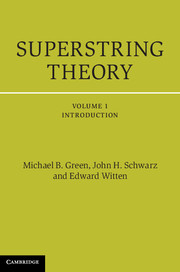6 - Nonabelian gauge symmetry
Published online by Cambridge University Press: 05 September 2012
Summary
If superstrings are to describe nature they must account not only for general coordinate invariance and local supersymmetry, but also for the local gauge symmetries that underly the other forces. Indeed, nonabelian gauge symmetry is more obviously needed than local supersymmetry! One possibility is that the gauge symmetries are not present at all in the tendimensional world, but arise only upon reduction to four dimensions. This idea, which seems to be forced upon us if we try to describe nature with type II superstrings, proves to have enormous difficulties. We will discuss these issues to some extent in chapter 14.
A more promising possibility is that gauge symmetries are present already in the ten-dimensional world. In this case, compactification from ten to four dimensions may play a role as part of an initial stage of symmetry breaking. In this chapter we investigate how gauge symmetries can be introduced in D = 10, and defer the study of compactification and symmetry breaking to later chapters.
Two entirely different procedures for incorporating gauge interactions are known. In the first one, which was already briefly described in §1.5.3, internal symmetry charges are placed at the ends of open strings. In the second the charges are distributed on closed strings. The second procedure leads to heterotic strings, which seem to have many advantages. Indeed, if one of the presently known superstring theories turns out to be the correct theory, it is almost bound to be the E8 × E8 heterotic theory.
- Type
- Chapter
- Information
- Superstring Theory25th Anniversary Edition, pp. 291 - 352Publisher: Cambridge University PressPrint publication year: 2012



